Costa Rica are competing in their first Copa America since 2016, having not been invited to the most recent two competitions.
However, on the international stage, Costa Rica have managed to reach the quarter-finals in the past two CONCACAF Gold Cups and reached the group stages at the past two World Cups as well.
Costa Rica have had mixed levels of form in the run-up to this Copa America, with four wins, eight losses and one draw.
As a result, it is difficult to get a good read of Costa Rica coming into the competition; however, most notably in their recent friendly against Argentina, they were outclassed in a 3-1 loss, so it is unlikely that they will be able to bridge the gap in time to make a serious push to win the entire tournament.
This tactical analysis breaks down the key players and tactics that Costa Rica have used this season.
This scout report will also break down how they play within the three primary phases of the game (attacking, defensive, and transitions).
We will also look at the players who will likely make the trip to the US and some who could significantly impact Costa Rica’s ability to succeed.
Predicted Starting XI
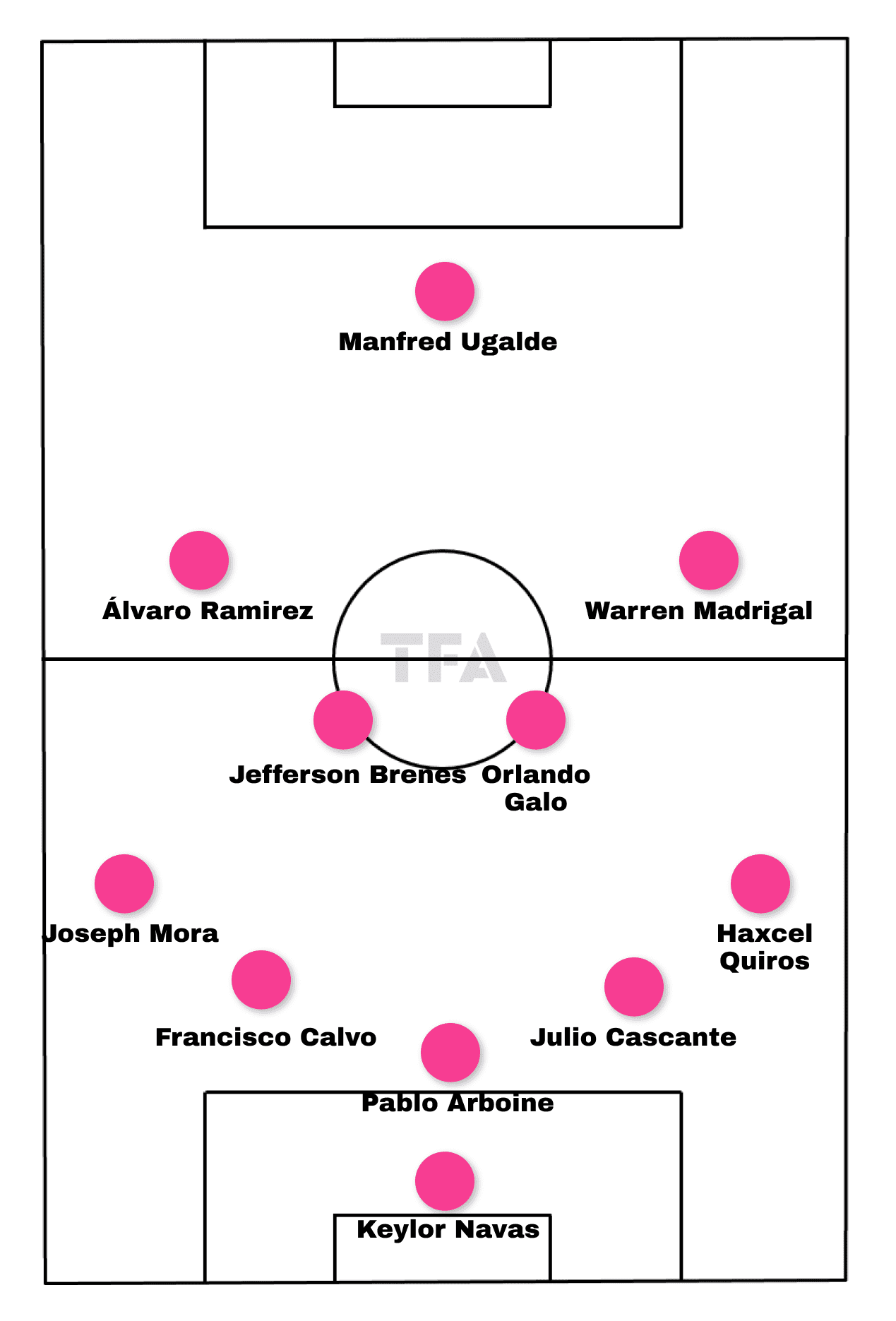
Gustavo Alfaro has used several formations this season, including 4-1-4-1, 4-2-3-1, and 5-4-1 shapes.
However, over the past four international breaks, he has shown a clear preference for playing with a back five, so we have gone with that formation for our predicted starting XI.
In goal, we have chosen goalkeeper and national icon Keylor Navas.
He has played a vital role for his national side over the years, and this may well be his last major international competition.
In front of Navas, we have gone with Francisco Calvo’s three centre-backs on the left, Pablo Arboine in the middle of the back three, and MLS central defender Julio Cascante in the right of the back three.
We could easily have gone with Juan Pablo Vargas, who has also played a significant number of minutes in the centre of defence for Costa Rica; however, he hasn’t played as much in recent games.
Then there are the wing-backs of Joseph Mora on the left and Haxzel Quirós, who both play in Costa Rica’s premier division, Liga Promerica.
Then comes the midfield four, where we have gone with Álvaro Zamora on the left, with Jefferson Brenes and Orlando Galo operating as the two central midfielders for Costa Rica.
Then, on the right wing, we went with Madrigal.
Then, to finish off the side, we have gone with centre-forward Manfred Ugalde, who is currently plying his trade in Europe for Spartak Moscow.
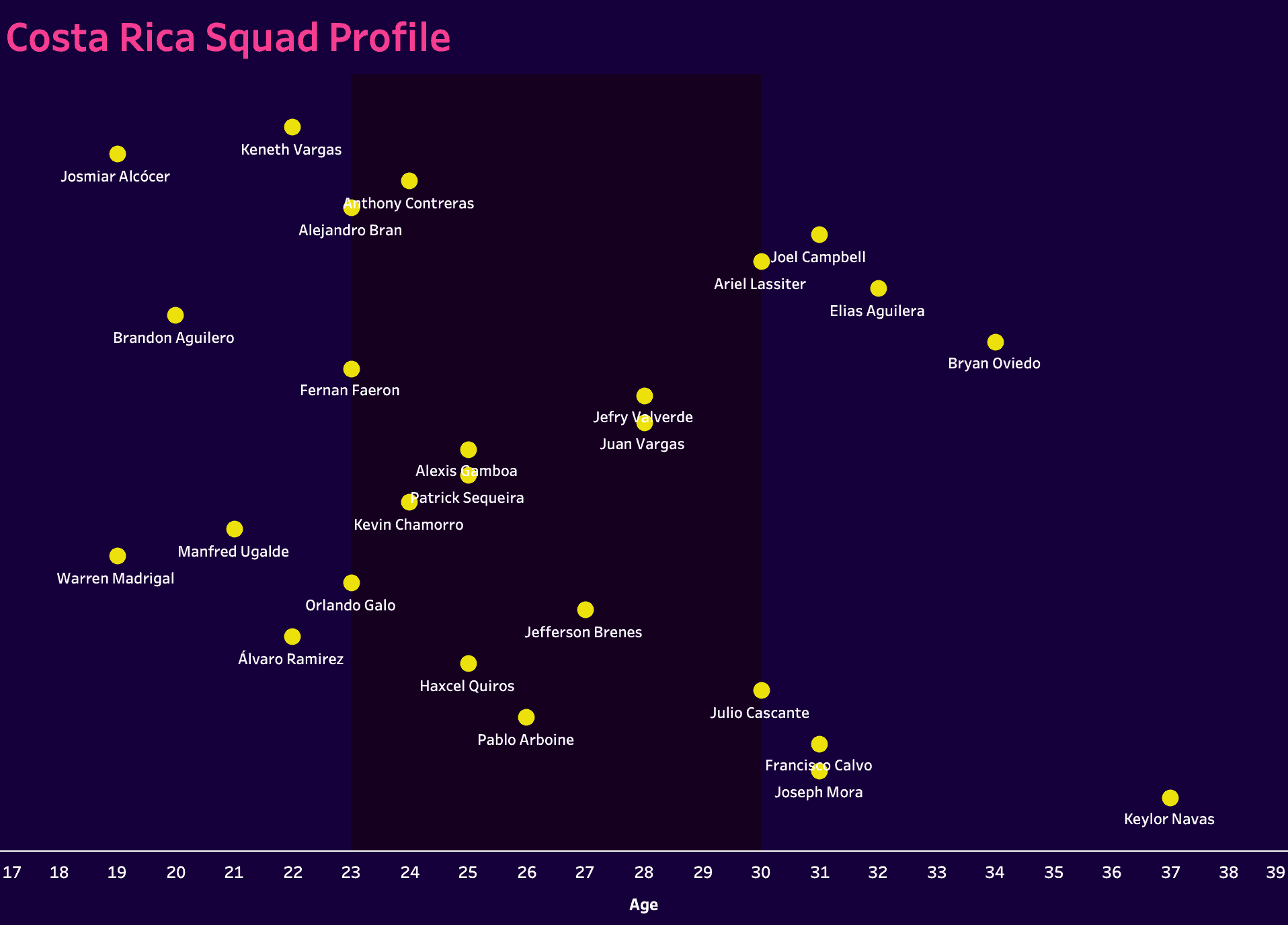
Attacking Phase
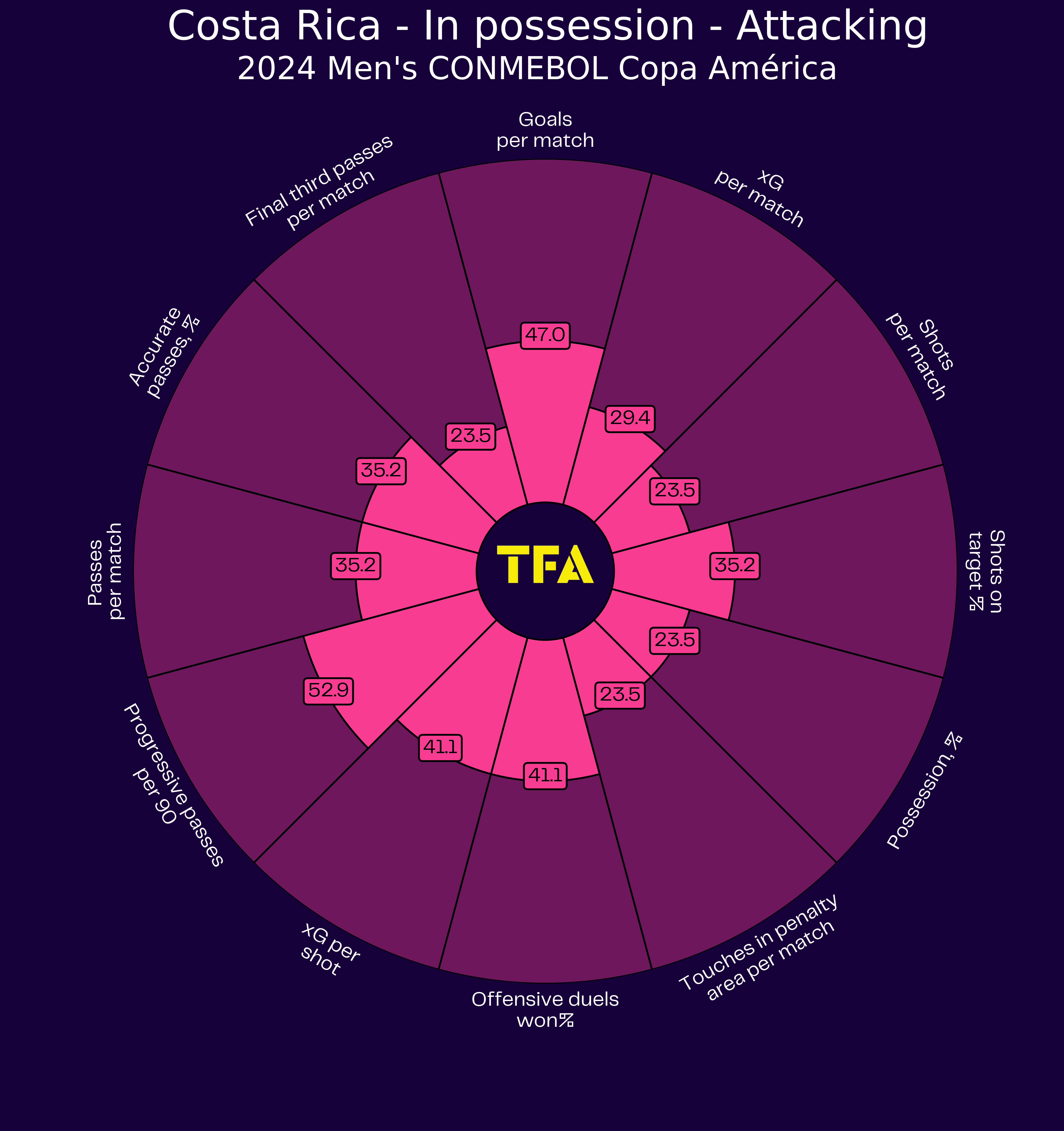
Costa Rica have had mixed success in attack leading up to the 2024 Copa America, with the side averaging 1.46 goals per 90, coming from the 1.23 xG per 90.
So, they are able to score consistently; these numbers may, however, be misleading as they have been playing in North American World Cup qualifying, and a 6-4 win over Martinique will certainly skew the data to some degree.
Having given a basic look at the numbers underlying Costa Rica’s attack, let’s look in more depth at how they are able to achieve this.
They have averaged 47.02% possession throughout this calendar year. They average around 409.54 passes per 90; despite this, they have been able to play an average of 65.08 progressive passes per 90, which puts them in the middle of the rest of the competition.
So despite struggling to keep possession for long periods, when they have had it, they have been effective at progressing it up the field.
Now, let’s take a look at what Costa Rica actually does in possession.
Let’s start from the back with Costa Rica in build-up play.
Costa Rica will look to attack in a 3-4-3 shape, stretching the field both vertically and horizontally, with the wing-backs hugging the touchline.
Then, the forwards will look to take on the opposition’s defensive line and run in behind the defence.
Costa Rica will look to patiently play the ball at the back and wait for the opportunity to get their forwards on the ball in attacking positions.
Costa Rica switched the ball from side to side, looking to play around the opposition’s shape.
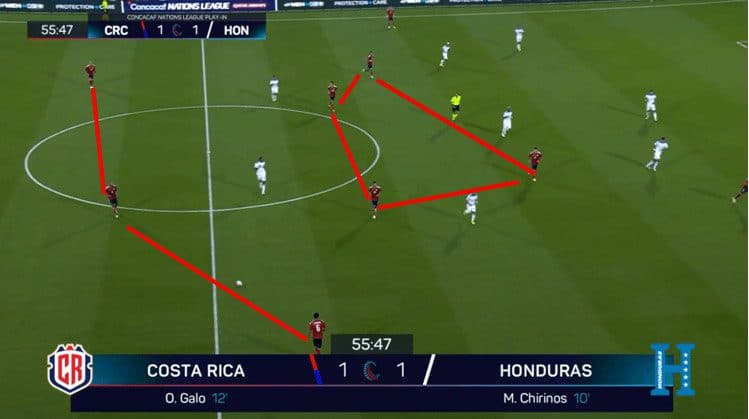
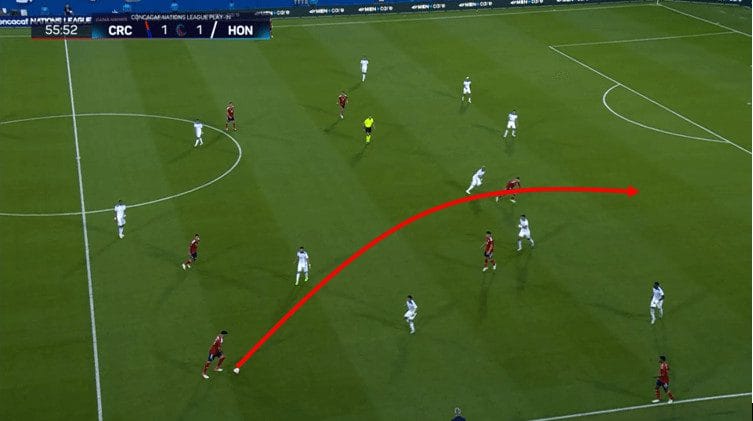
In the first image what you can see is the 3-4-3 shape with Costa Rica spreading their backline wide across the field.
The two wing-backs hugged the touchline.
Then, centrally, Costa Rica deployed a box midfield made up of the two wingers and the two central midfielders.
Then note how, in the second image, the Costa Rica centre-forward, Ugalde, makes a forward run off the ball beyond the Honduras backline to stretch the opposition’s shape vertically.
This is followed by some nice combination play, which results in a goal for Costa Rica by the onrushing Madrigal.
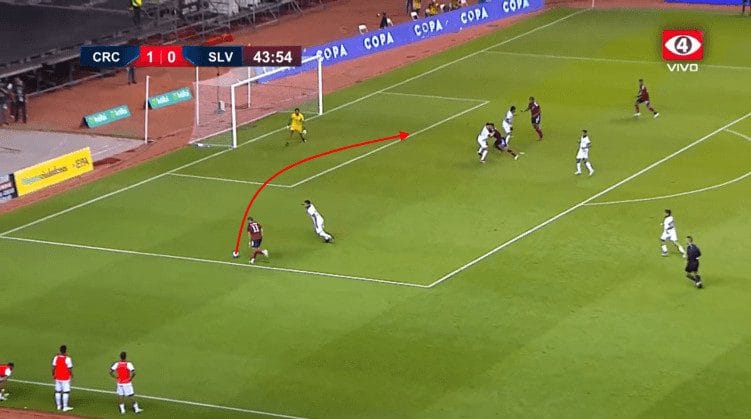
In the final third, Costa Rica have looked to create one-on-one situations out wide where they can put crosses into the box.
Just like in this example, with three targets and a midfielder coming into the box, Costa Rica look well set up to take advantage of this situation.
However, a lack of quality movement from Costa Rica and physical marking by Honduras prevent any Costa Rica player from getting free in the box and becoming a viable target to hit.
Defensive Phase
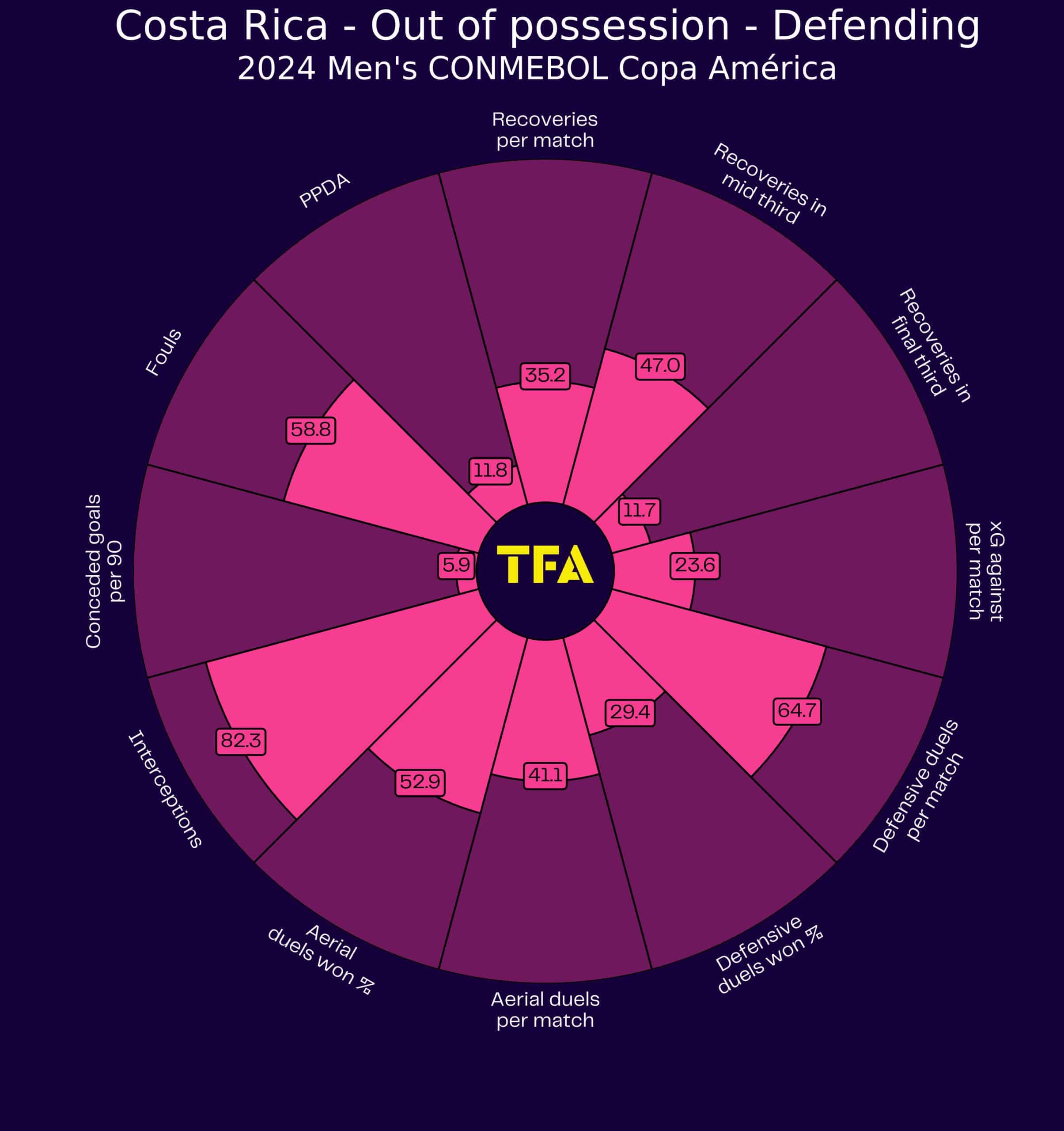
Coming into the competition, Costa Rica had one of the worst defensive records of any team that qualified for the competition—conceding an average of 2.08 goals per 90 and an xGA of 1.31.
This includes conceding four goals to Martinique, three goals to Panama twice, and Argentina once.
In addition, Costa Rica have one of the highest PPDAs in competition, averaging 11.62; this means that they are allowing more passes per defensive action than the majority of the team in the competition.
Despite this, they are completing in 70.08 defensive duels per 90, at a success rate of 59%, and they are also making 41.23 interceptions per 90.
So, they have demonstrated some ability to regain the ball defensively despite allowing a large amount of passes per action.
Having looked at some of the numbers that underlie Costa Rica’s defensive ability.
Let’s look at the principles they exhibit that result in these numbers.
One of the most notable aspects of Costa Rica in defence is their defensive shape is a 5-4-1 which can transition into a 5-2-3 when the opponent’s centre backs have the ball.
This change of shape is triggered by backward or poor passes towards the centre-backs and enables Costa Rica to force their opponents to rush their play, force mistakes out of them, and allow their three central defenders to compete aerially for the ensuing long ball.
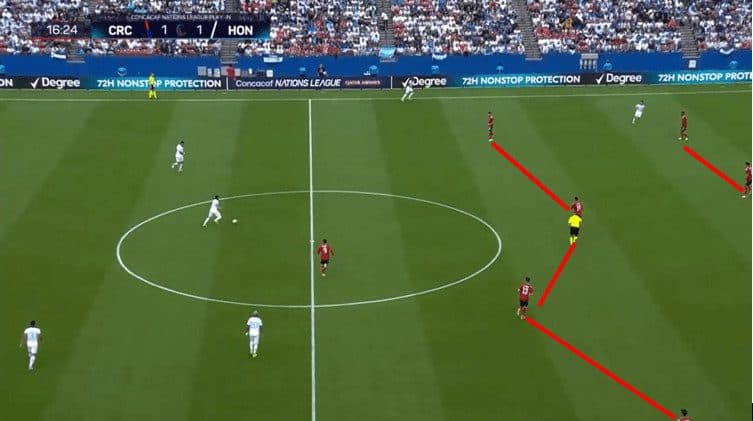
Here, you can see Costa Rica’s 5-4-1 shape.
What is noticeable is how spread out the midfield line is, with half spaces available for potential opponents.
However, when balls are played into the half-spaces, it is the nearest wide centre-back’s responsibility to press and put pressure on the ball.
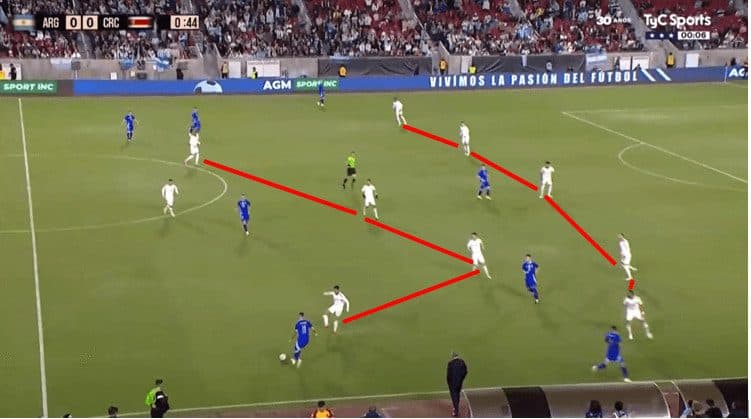
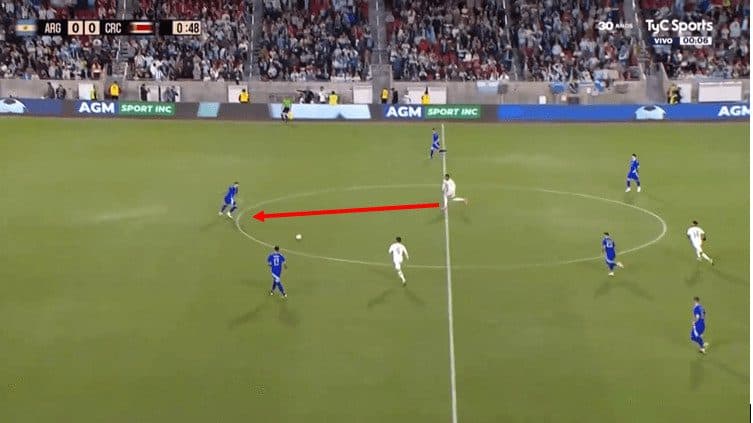
In this example against Argentina, Costa Rica started off in the 5-4-1 shape with the two wide players, left wing-back Lassiter and left winger Zamora, stepping up to put pressure on the ball out wide.
However, in this example, as the ball is played across to the opposite side of the field by Argentina, the blind side winger, Alcócer, jams in off the right side to put pressure on the Argentina centre-back.
This example demonstrates how congested Costa Rica can make the box and how this makes crossing into the box significantly more difficult for opponents.
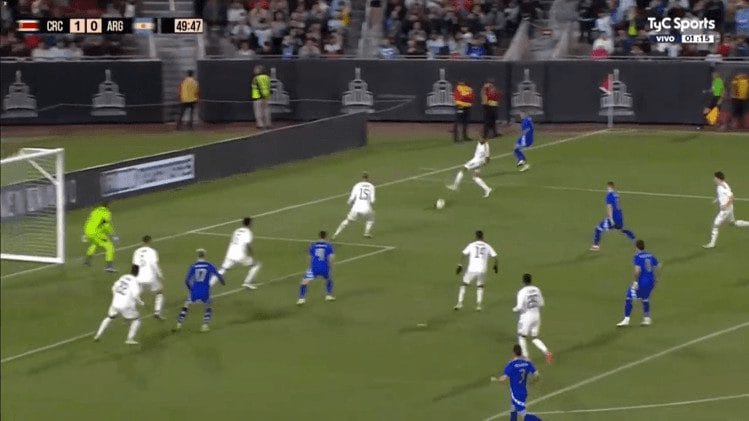
In addition to this ability to switch between a 5-4-1 and 5-3-2 shape, Costa Rica’s deep defensive shape is a 5-4-1, in which they will look to congest the box and prevent opponents from having any time or space to get a shot away.
Despite this, it should be noted that Costa Rica struggled against Argentina, which could play short, sharp passes in the box and eliminated Costa Rica’s congested box.
The congested box is best suited against teams who look to cross into the box from wide areas.
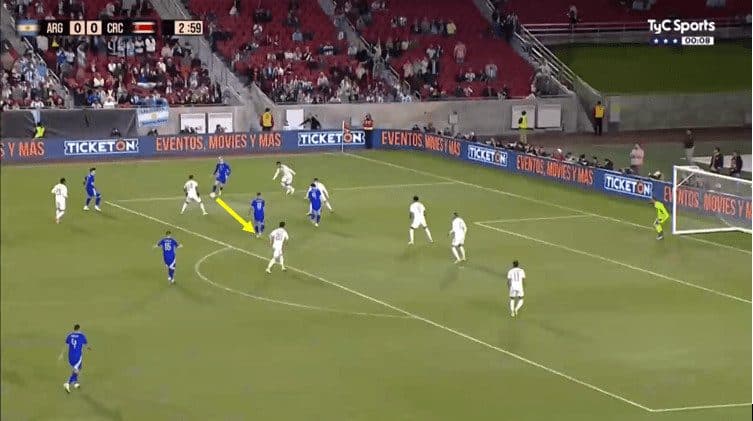
This example demonstrates how Argentina could find space in the box by playing passes to feet.
Benfica’s creative midfielder Ángel Di María finds space between the two lines and is able to receive and turn to get a shot away in the box.
Another aspect in which Costa Rica showed a lack of quality was pressing in the final third.
Los Ticos tried to press both Argentina and Honduras from the front at the start of both games; however, they struggled to get any traction on the ball and, as a result, could leave themselves exposed at the back.
They then switched back to a lower engagement line in both games, where they looked to operate in that 5-4-1 and 5-3-2 mid-block shape that we have previously highlighted.
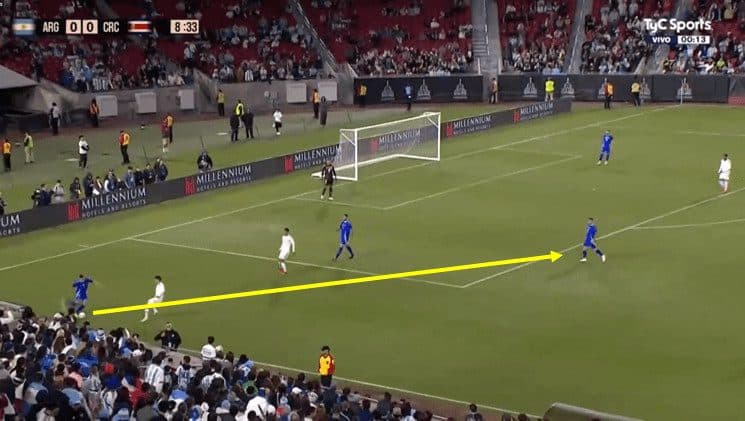
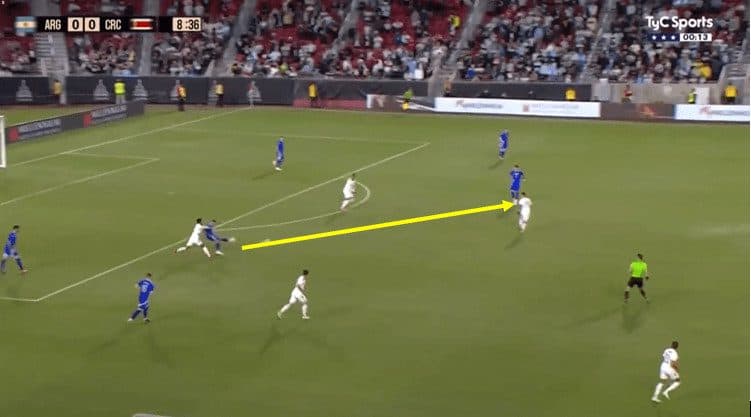
In this example, Argentina has played back and is hemmed in the corner, and Costa Rica’s front line is trying to put pressure on the Argentina backline; however, the rest of the Costa Rica side fails to follow, leaving Liverpool’s Alexis Mac Allister in space and enabling Argentina to take four Costa Rica players out of the game in two passes.
Transitions
Having looked at how Costa Rica looks to play in general play, let’s now look at how they look to play when chaos arises in periods of transition.
First of all, we will look at attack-defence transition.
Costa Rica’s best defence is a 3-4 shape, which gives them a lot of security on the counterattack when they lose the ball.
However, the midfield and defensive banks can become disconnected, and opponents can find space between the lines.
However, it is often closed down quickly.
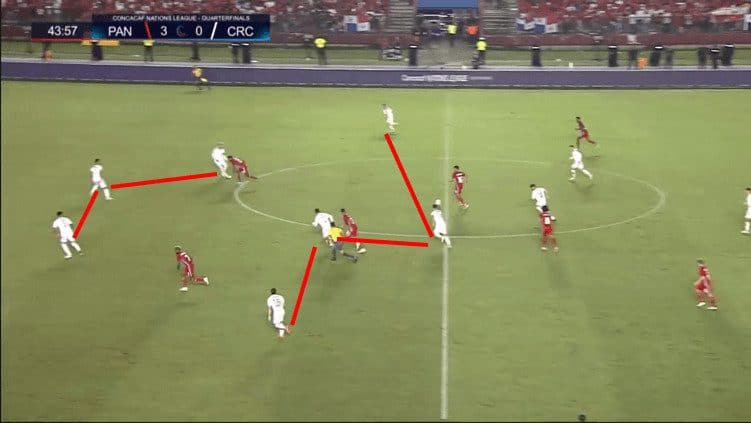
Here, you can see the 3-4 rest of Costa Rica’s defence shape, with the three central defenders offering deep security.
The two central midfielders are caught out too narrow and, as a result, leave a gap in the midfield for Panama to exploit, particularly as the two wing-backs are wide due to them trying to stretch the width of the field in attack.
This disconnect between central midfield and wing-back could create gaps in their shape that opponents could expose on the counterattack.
Earlier, we highlighted how Costa Rica have only averaged 47.02% possession.
As such, we would expect Costa Rica to try to profit from counterattacks as a source of chance creation.
Here, we will look at a few ways in which they have been effective on the counterattack.
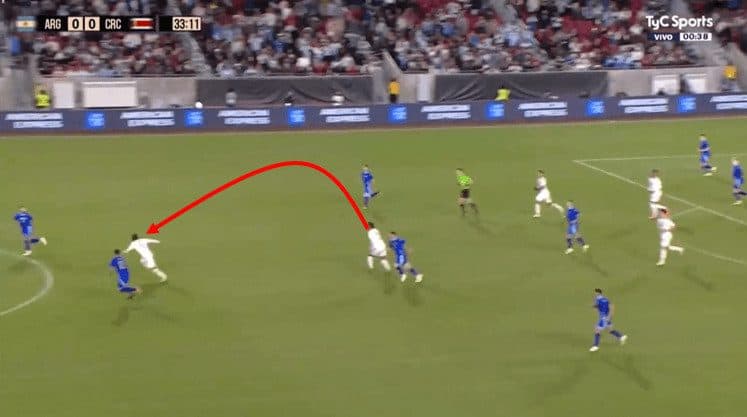
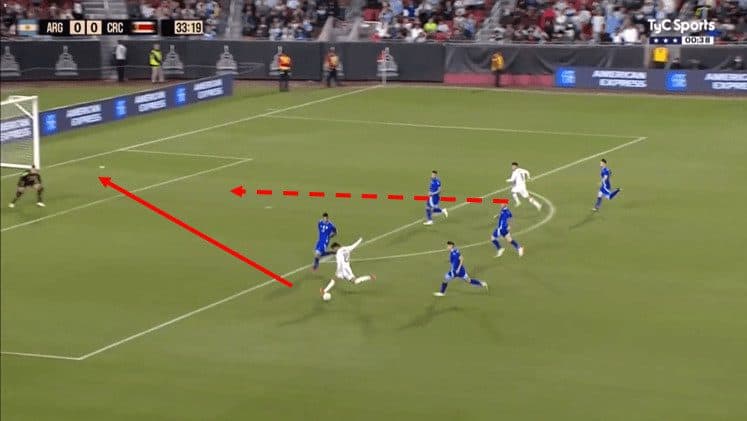
Here, Argentina is in an advantageous position.
Zamora is playing behind Ugalde, who remains high up the field.
Zamora is able to compete for the cleared ball and header it towards Ugalde.
Ugalde then finds Zamora, who is able to carry the ball to the edge of the box.
On the edge of the box, Zamora attempts a long-range left-footed shot.
Walter Benítez parries away this shot; however, it falls straight into the path of Ugalde, who duly converts to take the lead against the reigning World Champions.
Forwards
Having looked at how Costa Rica wants to play, let’s take a look at some of the options available to Costa Rica for this summer, starting with the forwards.
Let’s start with Manfred Ugalde, who started the season with Twente.
However, his form of 7 goals and 6 assists earned him a January window move to Spartak Moscow.
Ugalde will likely lead the line for Costa Rica, and his ability to be a focal point will be vital to Costa Rica’s success in this tournament.
As an alternate option to Ugalde, Costa Rica could go with Anthony Contreras, who has struggled for form this season in Cyprus, only scoring one goal in 626 minutes of first-team football.
In addition to Ugalde, Costa Rica also has Kenneth Vargas, who plays for Hearts in Scotland.
Vargas can play as a winger or a centre-forward and is at his best when he’s able to drive at opponents and create with his right foot down the right flank.
Costa Rica also has Josmiar Alcócer, a left winger who will look to cut inside onto his right foot.
Midfielders
Now, let’s take a look at some of the midfield options available to Costa Rica.
Let’s start with Jefferson Brenes, who plays for Dallas in the MLS.
Brenes is a central midfielder who has quality from set pieces that offer a different dimension to the Costa Rican side.
In addition to Brenes, Costa Rica also has Orlando Galo, who plays in Costa Rica as a central midfielder; however, he can also play as a right wing-back if needed.
The final classical centre midfield option Costa Rica have is Alejandro Bran, who plays in the MLS for Minnesota.
As alternate options to the aforementioned centre midfielders, Costa Rica also has several more creative attacking midfielders who could be called into the squad to give the side a different option.
The young creative midfielder Brandon Aguilera, who plays for Bristol Rovers, had a difficult season in terms of creative numbers this season, with him only being able to create an average of 0.07 xA per 90 in League One.
In addition to Aguilera, Costa Rica also have Elias Aguilar, who has amassed 22 caps already for Costa Rica and offers more experience to the squad.
Having looked at the central options for Costa Rica, let’s now look at the wide options for Costa Rica.
On the left, the main two options are the left-footed Ariel Lassiter, who is playing in the MLS for Montreal.
Alternatively, Costa Rica could go with the right-footed Álvaro Zamora, who currently plays in Greece.
On the right wing, Costa Rica have the 132-cap former Arsenal product Joel Campbell, who is currently playing for Alajuelense.
As an alternate option to the left-footed Campbell, Costa Rica could go with the nineteen-year-old young winger Warren Madrigal, who offers a more dynamic option than Campbell at this stage.
Defenders
Now, let’s look at the defensive options that Costa Rica could use for the Copa America this summer.
First of all, let’s look at the centre-back options for Costa Rica.
Costa Rica have Francisco Calvo from Juárez in Mexico, a left-footed centre-back.
In addition to Calvo, they can call upon Pablo Arboine, a right-sided centre-back who plays for Saprissa in Costa Rica.
Costa Rica also has Julio Cascante to call upon, who is currently playing in the MLS for Austin.
As alternate options to those mentioned, Costa Rica could call upon the left-footed centre-backs of Alexis Gamboa, who plays in Costa Rica, or Juan Vargas, who plays in Colombia for Millonarios.
Additionally, Costa Rica can call upon Fernan Faerron, who plays as a right-sided centre-back for Costa Rican side Herediano.
In addition to the central defence options, Costa Rica also has several wing-back options that it could call upon.
At right wing-back, Costa Rica doesn’t have a lot of natural depth.
However, Haxcel Quirós is the most likely option.
Alternatively, at left wing-back, Costa Rica have a couple of options in Joseph Mora, from Saprissa—Jefry Valverde, who is a more attacking wing-back and can also play further forward.
Finally, Costa Rica could also call upon Bryan Oviedo, who has amassed 81 international caps, and his experience could be valuable at the competition.
Key Player
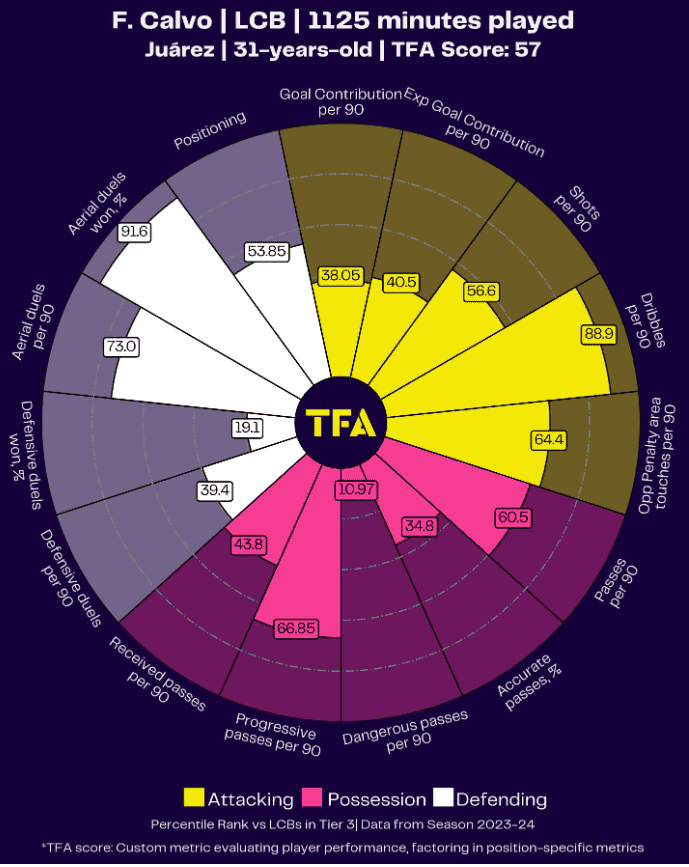
Throughout this tournament, Costa Rica are likely to come under significant duress defensively.
As a result, it is going to be vital that Costa Rica’s defence is strong.
As such, we will look at Francisco Calvo as a vital component to keeping opponents out of the goal.
Throughout the season for Juárez in Mexico, Calvo has averaged 4.44 aerial duels per 90 minutes at a success rate of 65.7%.
In addition, Calvo has averaged 6.4 interceptions per 90 minutes and 5.64 defensive duels per 90 minutes at a success rate of 65.7%.
Calvo’s Juárez side have also largely played on the back foot, averaging 48.84% of possession throughout the season.
As a result, Calvo should be used to defending under the cosh, which will be vital in helping his goalkeeper Navas behind him.
Tournament Prediction
This is Costa Rica’s first Copa America since 2016, having not been invited in the past two iterations.
However, they have qualified this year, but unfortunately, Costa Rica are in a complex group with Colombia, Brazil and Paraguay.
Where progression into the knockout stages is going to be difficult.
However, with the shot-stopping ability of Keylor Navas, there is undoubtedly some upset potential, and it would surely be seen as a success to progress out of the group stage.
Although we can see Paraguay progressing, it is unlikely, and we think they won’t progress beyond the group stage, with Brazil and Colombia likely progressing as the top two in the group.

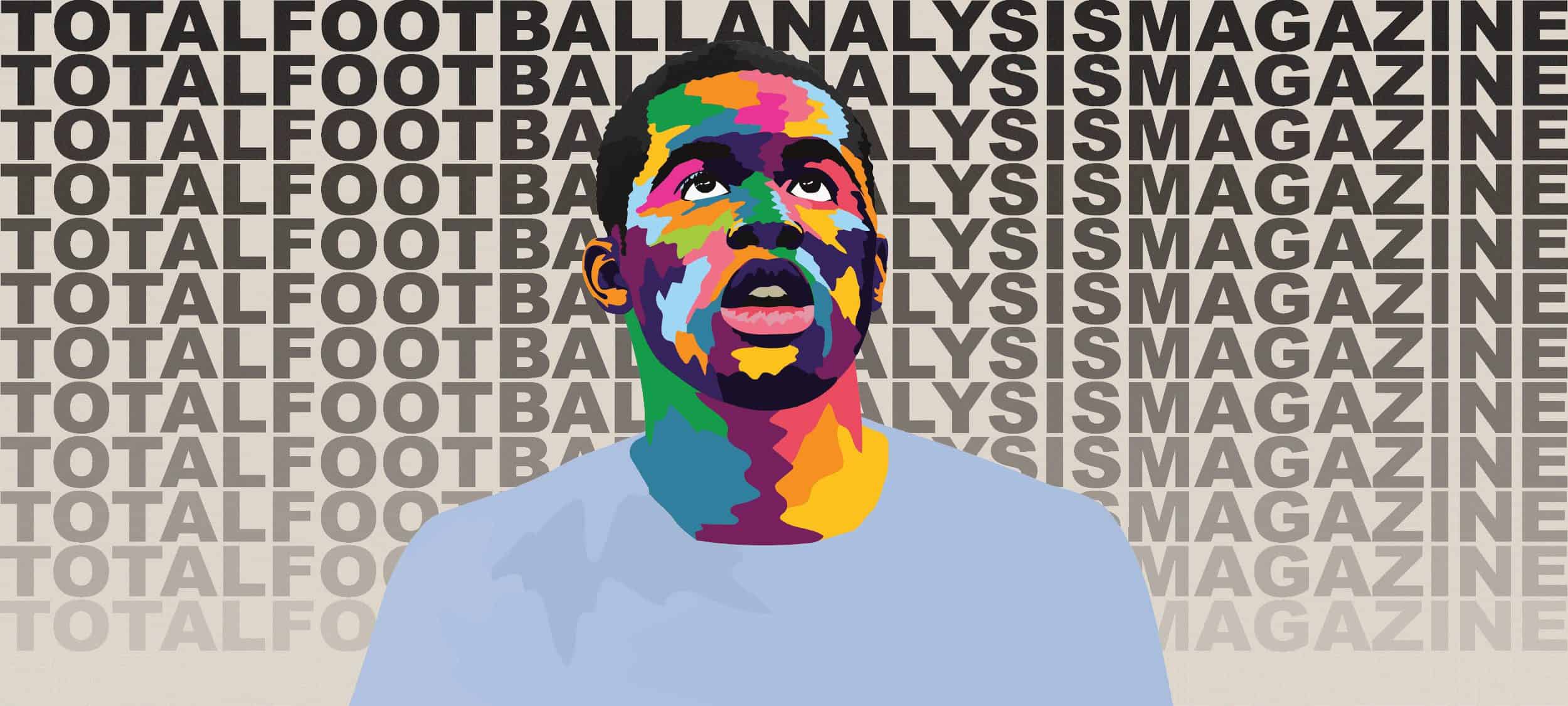




Comments